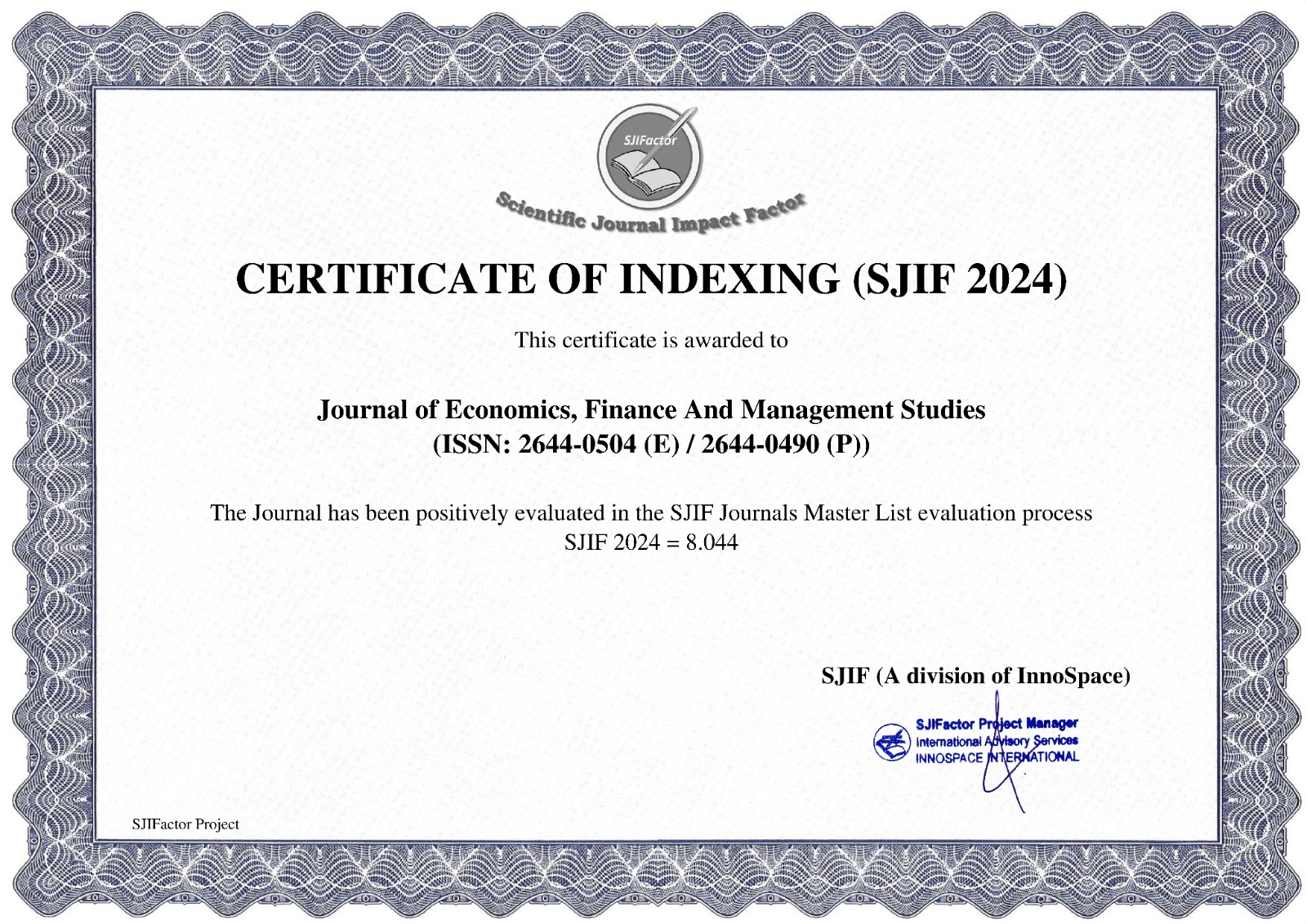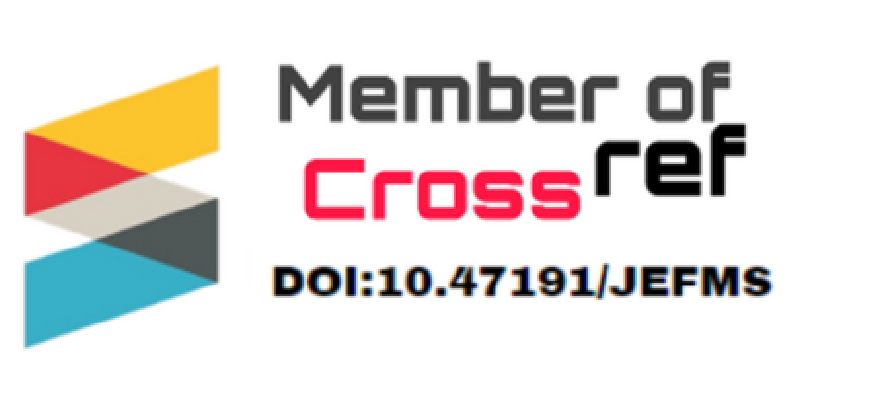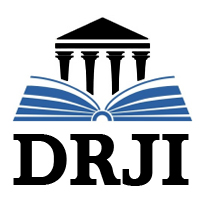The Impact of Loose Monetary Policy on Attracting Foreign Direct Investment (FDI) in Emerging Economies: Moderating Role of Inflation
1VO MINH VINH , 2PHAN QUYNH ANH, 3TRAN THI THUY LINH
1Faculty of Management and Economics, University of Tomas Bata
2Urban International School
3Faculty of International Business, University of Greenwich ORCID: https://orcid.org/0009-0006-3106-2150
https://doi.org/10.47191/jefms/v8-i2-21
ABSTRACT:
This study examines the impact of loose monetary policy, including money supply and interest rates, significantly influences Foreign Direct Investment (FDI). Moreover, it investigates the moderating effect of inflation on the interaction between monetary policy and FDI absorption. This study applied quantitative research methods and designed a 5-point Likert scale survey. Then, the study conducted descriptive analysis, Cronbach's Alpha test, EFA and moderator variable analysis. The results proved the money supply (0.82), interest rate (-0.65) influence FDI absorption in emerging economies and moderating unstandardised coefficient (0.723) of inflation. This research provides a novel exploration of how loose monetary policy impacts FDI adoption in emerging economies, emphasising the moderating role of inflation. Also, it offers actionable insights for policymakers to enhance FDI absorption while addressing the challenges posed by inflation dynamics.
KEYWORDS:
FDI, Money supply, Interest rate, Moderating role of inflation, emerging economies.
REFERENCES:
1) Agénor, P.R. and da Silva, L.A.P., 2013. Inflation targeting and financial stability: a perspective from the developing world. Washington, DC: Inter-American Development Bank.
2) Agyeman, A.S., Arthur, B. and Addai, B., 2021. Interest rates and FDI in some selected African countries: The mediating roles of exchange rate and unemployment. African Review of Economics and Finance, 13(1).
3) Akyüz, Y., 2011. Policy responses to the global financial crisis: key issues for developing countries. In Reforming the international financial system for development (pp. 105-142). Columbia University Press.
4) Alchian, A.A. and Klein, B., 1973. On a correct measure of inflation. Journal of Money, Credit and Banking, 5(1), pp.173-191.
5) Alfaro, L., Chanda, A., Kalemli-Ozcan, S. and Sayek, S., 2004. FDI and economic growth: the role of local financial markets. Journal of international economics, 64(1), pp.89-112.
6) Amirahmadi, H. and Wu, W., 1994. Foreign direct investment in developing countries. The Journal of Developing Areas, 28(2), pp.167-190.
7) Armknecht, P.A. and Ginsburg, D.H., 1992. Improvements in measuring price changes in consumer services: past, present, and future. In Output measurement in the service sectors (pp. 109-157). University of Chicago Press.
8) Asamoah, M.E., Alagidede, I.P. and Adu, F., 2022. Exchange rate uncertainty and foreign direct investment in Africa: Does financial development matter?. Review of Development Economics, 26(2), pp.878-898.
9) Babbie, E., 2010. The practice of social research. 12th ed. Belmont: Wadsworth.
10) Ball, L., Cecchetti, S.G. and Gordon, R.J., 1990. Inflation and uncertainty at short and long horizons. Brookings Papers on Economic Activity, 1990(1), pp.215-254.
11) Barbopoulos, L., Marshall, A., MacInnes, C. and McColgan, P., 2014. Foreign direct investment in emerging markets and acquirers’ value gains. International Business Review, 23(3), pp.604-619.
12) Barger, T. and Kuczynski, I., 1996. Investment funds in emerging markets (Vol. 2). World Bank Publications.
13) Batten, D.S., 1981. Inflation: The cost-push myth. Federal Reserve Bank of St. Louis Review, 63(6), pp.20-26.
14) Bekaert, G. and Harvey, C.R., 2003. Emerging markets finance. Journal of empirical finance, 10(1-2), pp.3-55.
15) Bellavitis, C., Filatotchev, I., Kamuriwo, D.S. and Vanacker, T., 2017. Entrepreneurial finance: new frontiers of research and practice: Editorial for the special issue Embracing entrepreneurial funding innovations. Venture Capital, 19(1-2), pp.1-16.
16) Bellemare, P., 2024. Analyzing the Impact of Money Market Dynamics on Economic Growth in Nigeria: Insights into Capital Structure, Liquidity, and Banking Sector Performance.
17) Berry, H., 2006. Shareholder valuation of foreign investment and expansion. Strategic Management Journal, 27(12), pp.1123-1140.
18) Brealey, R.A., Cooper, I.A. and Habib, M.A., 1996. Using project finance to fund infrastructure investments. Journal of applied corporate finance, 9(3), pp.25-39.
19) Brown, J.D., 2011. Likert items and scales of measurement. Statistics, 15(1), pp.10-14.
20) Bryman, A. (2012). Social research methods (4th ed.). Oxford University Press.
21) Cantwell, J. and Narula, R., 2001. The eclectic paradigm in the global economy. International Journal of the Economics of Business, 8(2), pp.155-172.
22) Chakrabarti, A., 2001. The determinants of foreign direct investments: Sensitivity analyses of cross‐country regressions. kyklos, 54(1), pp.89-114.
23) Chen, C.J. and Yu, C.M.J., 2012. Managerial ownership, diversification, and firm performance: Evidence from an emerging market. International Business Review, 21(3), pp.518-534.
24) Claessens, S. and Yurtoglu, B.B., 2013. Corporate governance in emerging markets: A survey. Emerging markets review, 15, pp.1-33.
25) Creswell, J.W. and Creswell, J.D., 2018. Research design: Qualitative, quantitative, and mixed methods approaches. 5th ed. Los Angeles: SAGE.
26) DAVISON, U.O., 2024. Effects Of Inflation Rate And Money Supply On Foreign Direct Investments In Nigeria. Nigerian Journal of Management Sciences Vol, 25, p.1b.
27) Dinh, T.T.H., Vo, D.H., The Vo, A. and Nguyen, T.C., 2019. Foreign direct investment and economic growth in the short run and long run: Empirical evidence from developing countries. Journal of Risk and Financial Management, 12(4), p.176.
28) Dixit, A.K., 1998. The making of economic policy: A transaction-cost politics perspective. MIT press.
29) Dunning, J.H., 1979. Explaining changing patterns of international production: In defense of the eclectic theory. Oxford Bulletin of Economics & Statistics, 41(4).
30) Edwards, S. and Lustig, N.C. eds., 2001. Labor markets in Latin America: combining social protection with market flexibility. Brookings Institution Press.
31) Eichengreen, B. and Hausmann, R., 1999. Exchange rates and financial fragility. [Online] National Bureau of Economic Research. Available at: https://www.nber.org/papers/w7418 [Accessed 27th December, 2024]
32) Engel, C., 2016. Exchange rates, interest rates, and the risk premium. American Economic Review, 106(2), pp.436-474.
33) Everaert, P., Sarens, G. and Rommel, J., 2010. Using transaction cost economics to explain outsourcing of accounting. Small Business Economics, 35, pp.93-112.
34) Fazira, D.R. and Cahyadin, M., 2018. The impact of interest rate, corruption perception index, and economic growth on foreign direct investment in ASEAN-6. Jurnal keuangan dan perbankan, 22(4), pp.707-713.
35) Frankel, J., 2010. Monetary policy in emerging markets. In Handbook of monetary economics (Vol. 3, pp. 1439-1520). Elsevier.
36) Friedman, B.M. and Kuttner, K.N., 2010. Implementation of monetary policy: How do central banks set interest rates?. In Handbook of monetary economics (Vol. 3, pp. 1345-1438). Elsevier.
37) Fujiwara, I., Hara, N., Hirakata, N., Watanabe, S. and Yoshimura, K., 2005. Monetary policy in a liquidity trap: What have we learned, and to what end?. International Finance, 8(3), pp.471-508.
38) Ha, J., Kose, M.A. and Ohnsorge, F. eds., 2019. Inflation in emerging and developing economies: Evolution, drivers, and policies. World Bank Publications.
39) Habanabakize, T. and Meyer, D.F., 2018. An investigation of the dynamic effect of foreign direct investment (FDI) and interest rates on GDP in South Africa. Journal of Economics and Behavioral Studies, 10(5 (J)), pp.29-37.
40) Hoang, H. and Bui, D., 2015. Determinants of foreign direct investment in ASEAN: A panel approach. Management Science Letters, 5(2), pp.213-222.
41) Hoskisson, R.E., Eden, L., Lau, C.M. and Wright, M., 2000. Strategy in emerging economies. Academy of management journal, 43(3), pp.249-267.
42) Islahiyah, N.A., 2024. Analyzing the Impact of Foreign Income on Local Currency Exchange Rates: A Comprehensive Study of Dynamics and Implications. Law and Economics, 18(3), pp.143-155.
43) Ismaila, M. and Imoughele, L.E., 2015. Macroeconomic determinants of economic growth in Nigeria: A co-integration approach. International Journal of Academic Research in Economics and Management Sciences, 4(1), pp.34-46.
44) Itagaki, T., 1981. The theory of the multinational firm under exchange rate uncertainty. Canadian Journal of Economics, pp.276-297.
45) Kaldor, N., 1985. The scourge of monetarism. Oxford; New York: Oxford University Press.
46) Khan, M.A., Khan, M.A., Khan, M.A., Hussain, S. and Fenyves, V., 2024. Justice and finance: Does judicial efficiency contribute to financial system efficiency?. Borsa Istanbul Review, 24(2), pp.248-255.
47) Khan, N. and Naushad, M., 2020. Inflation relationship with the economic growth of the world economy. Available at SSRN 3542729.
48) Khan, R. and Zahra, H., 2016. Impact of Domestic Interest Rate on Foreign Direct Investment (A case study of Pakistan). Bulletin of Business and Economics (BBE), 5(4), pp.220-230.
49) Kiplagat, B., 2016. The effects of interest rates on foreign direct investments in Kenya (Doctoral dissertation, University of Nairobi).
50) Krugman, P., 2017. Crises: The price of globalisation?. In Economics of Globalisation (pp. 31-50). Routledge.
51) Liu, K., Daly, K. and Varua, M.E., 2014. Analysing China's foreign direct investment in manufacturing from a high–low technology perspective. Emerging Markets Review, 21, pp.82-95.
52) Loy, J.P. and Weiss, C., 2019. Product differentiation and cost pass‐through. Journal of Agricultural Economics, 70(3), pp.840-858.
53) Machlup, F., 1960. Another view of cost-push and demand-pull inflation. The Review of Economics and Statistics, pp.125-139.
54) McCONNELL, C.R., 1956. Unions, purchasing power, and employment. The Southwestern Social Science Quarterly, pp.351-364.
55) Merna, T. and Njiru, C., 2002. Financing infrastructure projects. Thomas Telford.
56) Mishkin, F.S. and Savastano, M.A., 2007. Monetary policy strategies for Latin America.
57) Mishkin, F.S., 1981, January. The real interest rate: An empirical investigation. In Carnegie-Rochester conference series on public policy (Vol. 15, pp. 151-200). North-Holland.
58) Moosa, I., 2002. Foreign direct investment: Theory, evidence and practice. Palgrave.
59) Moschella, M. and Pinto, L., 2019. Central banks’ communication as reputation management: How the Fed talks under uncertainty. Public administration, 97(3), pp.513-529.
60) Mugableh, M.I., 2015. Time series analysis of inward foreign direct investment function in Malaysia. Procedia-Social and Behavioral Sciences, 172, pp.679-685.
61) Mukhtarov, S., Alalawneh, M.M., Azizov, M. and Jabiyev, F., 2020. The Impact of Monetary Policy and Tax Revenues on Foreign Direct Investment Inflows: An Empirical Study on Jordan. Acta Universitatis Agriculturae et Silviculturae Mendelianae Brunensis, 68(6).
62) Nathan, O.P.S., 2023. Money Supply and the Liquidity of Deposit Money Banks in Nigeria. World Journal of Finance and Investment Research, 7(2), pp. 77-98. DOI: 10.56201/wjfir.
63) Ndikumana, L., 1999. Debt service, financing constraints, and fixed investment: evidence from panel data. Journal of Post Keynesian Economics, 21(3), pp.455-478.
64) Odumusor, C.J., 2019. Impact of money supply on the growth of the Nigerian economy. Journal of Economics and Finance, 10(1), pp.30-46.
65) Okonkwo, R.I., Egbunike, F.C. and Udeh, F.N., 2015. Foreign direct investment and economic growth in Nigeria. Developing Country Studies, 5(9), pp.47-52.
66) Opeyemi, A.F., 2020. Impact of foreign direct investment and inflation on economic growth of five randomly selected Countries in Africa. Journal of Economics and International Finance, 12(2), pp.65-73.
67) Perera, A., 2010. Monetary Policy in Turbulent Times: Impact of Unconventional Monetary Policies. Available at SSRN 1669948.
68) Poncet, P. and Portait, R., 2022. Vanilla Floating Rate Instruments and Swaps. In Capital Market Finance: An Introduction to Primitive Assets, Derivatives, Portfolio Management and Risk (pp. 205-253). Cham: Springer International Publishing.
69) Rajeev, S., 2023. Inflation and Monetarism: An Analysis. Asian Journal of Managerial Science, 12(1), pp.51-57.
70) Sader, F., 2000. Attracting foreign direct investment into infrastructure: Why is it so difficult? (Vol. 12). World Bank Publications.
71) Sahoo, M. and Sahu, P., 2023. Does the effectiveness of money supply and foreign direct investment determine the industrial growth performance in India?. Theoretical & Applied Economics, 30(2).
72) Salim, A., 2019. Inflation: Types, causes and effects. Impact Journals, 7(1), pp.343-350.
73) Schneider, F. and Frey, B.S., 1985. Economic and political determinants of foreign direct investment. World development, 13(2), pp.161-175.
74) Siddiqui, H.A.A. and Aumeboonsuke, V., 2014. Role of interest rate in attracting the FDI: Study on ASEAN 5 economy. International Journal of Technical Research and Applications, 2(3), pp.59-70.
75) Singhania, M. and Gupta, A., 2011. Determinants of foreign direct investment in India. Journal of international trade law and policy, 10(1), pp.64-82.
76) Stockhammer, E. and Onaran, O., 2013. Wage-led growth: theory, evidence, policy. Review of Keynesian Economics, 1(1), pp.61-78.
77) Stopford, J.M., Strange, S. and Henley, J.S., 1991. Rival states, rival firms: Competition for world market shares (No. 18). Cambridge University Press.
78) Stulz, R.M., 2009. Globalization, corporate finance, and the cost of capital. In Global Corporate Governance (pp. 106-134). Columbia University Press.
79) Summers, L.H., 1982. The nonadjustment of nominal interest rates: A study of the Fisher effect.
80) Swianiewicz, P. ed., 2004. Local government borrowing: Risks and rewards. Open Society Institute.
81) Swick, R., Bathgate, D. and Horrigan, M., 2006. Services Producer Price Indices: past, present, and future. Comunicación presentada en el.
82) Tafti, F.C., 2012. Determinants of inflation in Islamic Republic of Iran. International Journal of business and social Science, 3(6).
83) Tobin, J., 1989. Money, capital, and other stores of value. In General equilibrium models of monetary economies (pp. 25-37). Academic Press.
84) United Nations Conferences on Trade and Development (UNCTAD), 1999. WORLD INVESTMENT REPORT 1999: Foreign Direct Investment and the Challenge of Development. [online] United Nations publication. Available at: https://unctad.org/publication/world-investment-report-1999. [Accessed 17 December, 2024]
85) Wahyudin, A., 2024. The Role of Monetary Policy in Addressing Economic and Financial Challenges: Effective Strategies for Managing Inflation and Growth. Journal of Multi Currency, 1(1), pp.1-13.
86) White, W.R., 2009. Should monetary policy ‘lean or clean’?. Federal Reserve Bank of Dallas, Globalization and Monetary Policy Institute Working Paper, 34.
87) Wu, S. and Pan, Q., 2021. Economic growth in emerging market countries. Global Journal of Emerging Market Economies, 13(2), pp.192-215.
88) Yamin, M. and Sinkovics, R.R., 2009. Infrastructure or foreign direct investment?: An examination of the implications of MNE strategy for economic development. Journal of world business, 44(2), pp.144-157.
89) Yang, X. and Shafiq, M.N., 2020. The impact of foreign direct investment, capital formation, inflation, money supply and trade openness on economic growth of Asian countries. iRASD Journal of Economics, 2(1), pp.25-34.
90) Zhao, H., Luo, Y. and Suh, T., 2004. Transaction cost determinants and ownership-based entry mode choice: A meta-analytical review. Journal of international business studies, 35, pp.524-544.
















